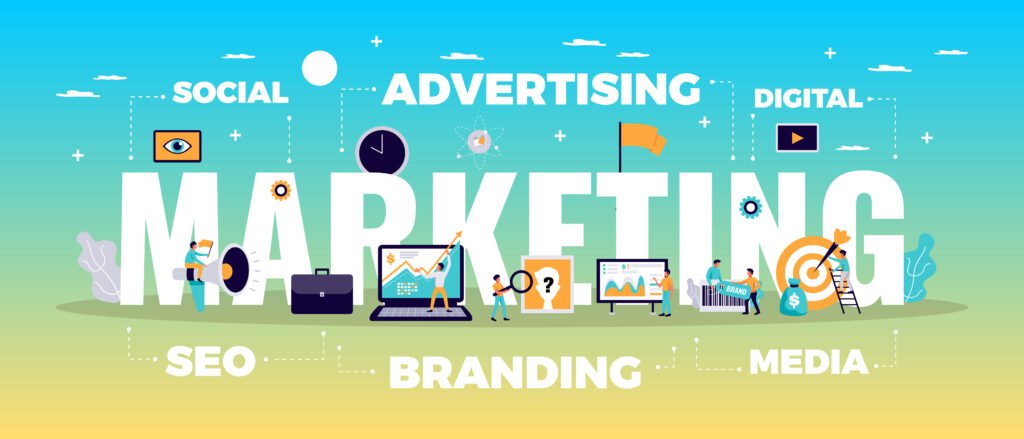In today’s fast-paced, digital-first world, digital marketing has become an essential pillar for businesses to thrive. Whether it’s building a brand, launching a product, or connecting with a global audience—digital marketing enables all of it. But the magic doesn’t stop there. Behind every high-performing campaign lies a team of creative minds working in video editing, photo editing, motion graphics, and graphic design. These skills are not just complementary to digital marketing—they’re the heartbeat of modern content creation. If you’re a student pursuing any of these fields, this guide is tailored to help you map out your learning journey, sharpen your skills, and build a successful career.

Educational Pathways
Embarking on a career in digital marketing or multimedia starts with choosing the right educational resources. Fortunately, there are a wealth of free and paid courses online. For digital marketing, platforms like Google Digital Garage, HubSpot Academy, and Meta Blueprint offer certifications that are industry-recognized and beginner-friendly. For video editing, tutorials for Adobe Premiere Pro, DaVinci Resolve, and Final Cut Pro are widely available on YouTube, LinkedIn Learning, and platforms like Skillshare.
Photo editors can benefit from courses on Adobe Photoshop and Canva Design School, while motion graphic artists should consider learning Adobe After Effects or Blender via School of Motion or Motion Design School. For graphic designers, courses from Coursera’s CalArts Graphic Design Program, Adobe Illustrator tutorials, and Figma resources are excellent starting points.
Besides structured learning, internships provide real-world exposure, giving students the chance to apply what they’ve learned in live projects. Hands-on experience improves not just your technical skill but also your understanding of deadlines, client requirements, and teamwork. Look out for internships on platforms like Internshala, LinkedIn, or AngelList.
Skills Development
To succeed in these fields, certain core skills are essential. Digital marketers need to understand SEO, content strategy, social media marketing, and data analytics. Video editors must grasp the fundamentals of editing techniques, sound design, visual storytelling, and color grading. Photo editors should be proficient in retouching, composition, and color correction, while motion graphic designers require knowledge of animation principles, keyframing, and motion tracking. Graphic designers must master typography, layout, branding, and visual hierarchy.
The best way to develop these skills is through consistent practice. Set aside time each day to follow tutorials, recreate ad campaigns, participate in creative challenges like Daily UI, or work on mock brand projects. Platforms such as YouTube, Skillshare, and Coursera provide endless content to help you progress from beginner to advanced levels.
Tools and Software
Mastering the right tools can give you a massive edge in your career. For video editing, top tools include Adobe Premiere Pro, Final Cut Pro (for Mac users), and DaVinci Resolve, which offers a powerful free version. For photo editing, professionals rely on Adobe Photoshop, Lightroom, and Canva for quick designs.
Motion graphics artists primarily use Adobe After Effects, along with Blender or Cinema 4D for 3D animation. Graphic designers prefer Adobe Illustrator, Figma, and CorelDRAW for creating logos, posters, and brand identities. Most of these platforms offer student discounts, and you can find beginner-to-advanced tutorials on their official websites or on educational hubs like Tuts+, Envato, and DesignCourse.
Portfolio Building
A solid portfolio is your golden ticket to job interviews, freelance gigs, and creative collaborations. It’s a visual resume that showcases your talent, style, and versatility. For digital marketing, your portfolio can include analytics reports, campaign breakdowns, content calendars, and ad copy samples. For video editing, compile a reel of 3–5 short projects, ideally showing a mix of storytelling, transitions, and sound syncing.
Photo editors should present a gallery of before-and-after images, retouches, and color enhancements. Motion designers can include logo animations, explainer videos, and kinetic typography. Graphic designers should display poster designs, branding kits, social media templates, and infographics. Host your portfolio on platforms like Behance, Dribbble, or build a personal website using WordPress or Webflow.
Industry Trends
The creative and marketing industries evolve fast, and staying updated is critical. Currently, AI tools like ChatGPT, Canva’s Magic Design, and Adobe Firefly are streamlining the creative process. Short-form video content is dominating social media, making skills in editing and motion design more valuable than ever. 3D and augmented reality (AR) content is also on the rise, offering immersive experiences to users.
Looking ahead, we can expect more integration of voice search optimization, programmatic advertising, and interactive content. Creatives should prepare by learning to work with emerging tools and platforms and staying agile in adapting to new formats. Following sites like Marketing Dive, Adobe Creative Blog, and Motionographer can keep you informed of the latest industry movements.
Networking and Community
In creative fields, who you know often matters as much as what you know. Building a network of peers, mentors, and industry professionals can open up opportunities you didn’t know existed. Start by joining LinkedIn groups focused on digital marketing or creative design. Engage in Reddit communities like r/VideoEditing, r/DigitalMarketing, and r/Design for daily discussions and feedback.
Many creators and learners connect on Discord servers such as “Design Buddies” or “Editor’s Retreat.” Don’t underestimate the power of attending virtual events like Adobe MAX, Google Marketing Live, or local portfolio review meetups. These platforms let you showcase your work, receive constructive feedback, and learn from professionals around the world.
Conclusion: Stay Curious, Stay Creative
Whether you want to become a social media strategist, a video content creator, a graphic designer, or a motion graphics artist, your future is filled with opportunities. The digital landscape is expanding, and the demand for skilled creatives and marketers is only going to grow. The key to success lies in consistency, curiosity, and courage. Keep learning new tools, experimenting with styles, and pushing your creative boundaries.
Remember, every expert was once a beginner. Your journey has just started—but with the right mindset and resources, you’re already ahead of the game. Stay inspired, stay motivated, and let your creativity lead the way.
